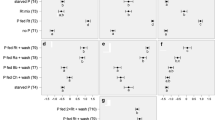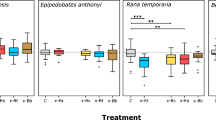Abstract
The production of diapausing eggs by Daphnia magna stimulated by fish exudates can be explained as an anti-predator defence ensuring genome protection in periods of high risk from fish predation. The combined effects on the induction of D. magna diapause of an “alarm” chemical originating from injured conspecific prey and fish kairomones were tested. The results of the experiment showed that the cues when present together promote both the production of ephippial eggs and male formation, indicating their role in the synchronization of the entire mode of Daphnia sexual reproduction. Ephippial eggs were only produced in the presence of both fish kairomone and conspecific alarm chemicals, while male offspring occurred in the treatments where both, one or none of the cues were present. However, production of males was the highest when both cues were provided. D. magna responded similarly to the tested cues whether or not the hypothetical alarm substance associated with predator odour came from Daphnia specimens actually eaten by fish or from crushed conspecific individuals. However, chemicals from crushed chironomid larvae combined with fish kairomones did not induce a similar response in D. magna. The relative advantage of utilization of alarm cues or predator kairomones in the induction of defence responses in prey organisms is discussed.
Similar content being viewed by others
Author information
Authors and Affiliations
Additional information
Received: 8 June 1998 / Accepted: 11 January 1999
Rights and permissions
About this article
Cite this article
Ślusarczyk, M. Predator-induced diapause in Daphnia magna may require two chemical cues. Oecologia 119, 159–165 (1999). https://doi.org/10.1007/s004420050772
Issue Date:
DOI: https://doi.org/10.1007/s004420050772




